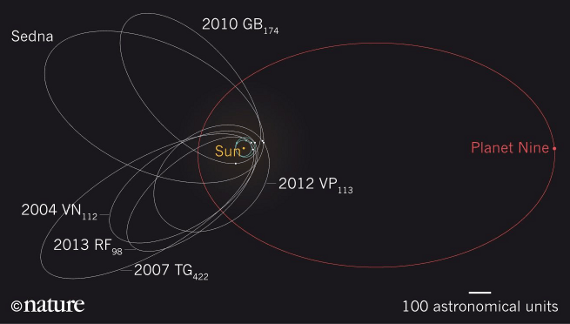Following the release of evidence presented by Konstantin Batygin and Mike Brown, two planetary scientists from the California Institute of Technology in January of this year, the hunt is on to find what’s been termed as “Planet Nine” – a world, perhaps 10 times as massive as Earth and four times its size – that scientists think could be lurking somewhere in the outer reaches of our solar system.
Other teams have been quick on the uptake, and since then, have analyzed archived images and submitted new proposals for further observations with the world’s largest telescopes. But are they barking up the wrong tree?
Apparently not. Just this month, evidence from the Cassini spacecraft orbiting Saturn helped close in on the missing planet. How? Well, believe it or not, it’s amazingly simple.
Batygin and Brown made the case for Planet Nine’s existence based on a technique used before by other astronomers: the gravitational effect it exerts on other astronomical bodies. In this case, several Kuiper Belt objects, (icy bodies that circle the sun beyond Neptune’s orbit).

The thing is, when you extend this theory a little further, if Planet Nine existed, its gravity should also tug slightly on the planets, moons and even any orbiting spacecraft. So, with this in mind, Agnès Fienga – along with her colleagues at the Côte d’Azur Observatory in France – checked the data they had collected, including slight perturbations seen in Cassini’s orbit, against the possibility they might be caused by the new addition of our mystery planet.
Guess what? The readings point toward something being there. (Such deviations cannot be accounted for by any of the eight planets in the solar system, its 200 major asteroids, and five of the most massive Kuiper Belt objects).
To check these findings, Fienga and her colleagues compared the updated model against a series of “proposed” Planet Nine’s at various points in a hypothetical orbit. Then they compared the data again. By repeating the process over and over, they discovered a sweet spot about 90 billion kilometers (fifty-five billion miles) away toward the constellation Cetus that accounts for Cassini’s orbit quite well. Although Fienga is not yet convinced that she has found Planet Nine, most outside experts are blown away.
“It’s a brilliant analysis,” says Greg Laughlin, an astronomer at Lick Observatory, who was not involved in the study. “It’s completely amazing that they were able to do that so quickly.”
But the good news doesn’t end there. If Planet Nine is located toward the constellation Cetus, then it could be picked up by the Dark Energy Survey, a Southern Hemisphere cosmological observation project designed to probe the acceleration of the universe. Excellent news indeed.
Laughlin thinks this latest survey has the best chance of success. He is also excited by the fact that Planet Nine could be so close – roughly 15 times the average distance to Pluto – because the Dark Energy Survey isn’t the only chance of discovering this faint new world. And now astronomers know where to look, it should be possible to detect the millimeter-wavelength light the planet radiates from its own internal heat.
The great news is cosmologists have already started to comb through data from existing experiments, and astronomers from all sorts of different specialties have also joined the search. In the meantime Batygin and Brown are hoping to secure a dedicated survey of their own. In a recent study, they searched through various sky maps to determine where Planet Nine cannot be, so they can devote their limited time more fruitfully. Once they’ve determined where the best place to study is, they intend to request roughly 20 observing nights on the Subaru Telescope on Mauna Kea in Hawaii. “It’s a pretty big request compared to what other people generally get on the telescope,” Brown says. “We’ll see if they bite.”
If they do, Brown is convinced the mysterious planet will be pinpointed within a year.
“I really want to see what it looks like,” says Batygin, who adds that his ambition drives him to continue the search for the unseen world. Laughlin, however, takes it a step further: “I think the discovery would provide amazing inspiration for the next stage of planetary exploration,” he says. “We now have another opportunity to see one of the worlds of our own solar system for the first time.”
Authors Note:
Source material: ScientificAmerican.com.











Recent Comments